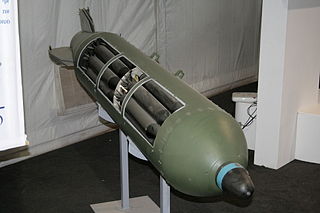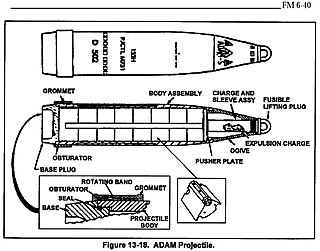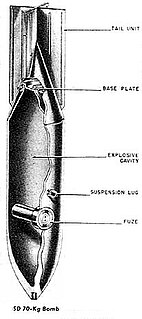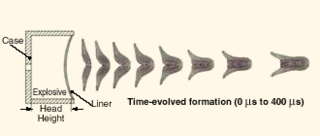
A bomb is an explosive weapon that uses the exothermic reaction of an explosive material to provide an extremely sudden and violent release of energy. Detonations inflict damage principally through ground- and atmosphere-transmitted mechanical stress, the impact and penetration of pressure-driven projectiles, pressure damage, and explosion-generated effects. Bombs have been utilized since the 11th century starting in East Asia.
The GATOR mine system is a United States military system of air-dropped anti-tank and anti-personnel mines developed in the 1980s to be compatible with existing cluster dispensers. It is used with two dispenser systems—the Navy 230 kg (500 lb) CBU-78/B and the Air Force 450 kg (1,000 lb) CBU-89/B. Additionally the mines are used with the land- and helicopter-based Volcano mine system.

Anti-runway penetration bombs are systems involving bombs or bomblets designed to disrupt the surface of an airfield runway and make it unusable for flight operations.
The CBU-97 Sensor Fuzed Weapon is a United States Air Force 1,000-pound (450 kg)-class non-guided (freefall) Cluster Bomb Unit (CBU). It was developed and produced by Textron Defense Systems. The CBU-97 in conjunction with the Wind Corrected Munitions Dispenser guidance tail kit, which converts it to a precision-guided weapon, is designated CBU-105.

The AA mine discharger was a Japanese anti-aircraft weapon of the Second World War. The device was a simple tube like an infantry mortar of 70 mm or 81 mm caliber. Instead of a standard mortar bomb, the projectile was a tube containing seven individual mines, each approximately 11/16ths of an inch in diameter (18 mm) and 3 inches (76 mm) long. Each mine was equipped with its own parachute. When fired, the mortar threw the shell to a range of 3,000 to 4,000 feet and a maximum altitude of approximately 600 m. The shell ejected the mines at the top of its arc. They would then float down on their parachutes. They were fused to detonate on contact or after a fixed time period, damaging nearby aircraft. The projectile could alternatively be launched using a standard Type 11 70 mm infantry mortar.

A Dual-Purpose Improved Conventional Munition (DPICM) is an artillery or surface-to-surface missile warhead designed to burst into sub-munitions at an optimum altitude and distance from the desired target for dense area coverage. The sub-munitions use both explosively formed penetrators for anti-armor work and fragmentation for antipersonnel work. Some sub-munitions may be designed for delayed reaction or mobility denial (mines). The air-to-surface variety of this kind of munition is better known as a cluster bomb. They are banned by some countries under the Convention on Cluster Munitions.
Gravel mines, also called Button mines, were small United States made air-dropped anti-personnel mines. They were used extensively during the Vietnam War as part of the McNamara Line. They were also used as a rapid-deployment area denial expedient, to provide a barrier during combat search and rescue (CSAR) operations between downed pilots or other endangered units and infantry threats.

Area Denial Artillery Munition (ADAM) is a family of United States land mines and 155 mm artillery projectiles.

The VS-50 is a circular plastic cased anti-personnel blast mine, formerly manufactured by the now-defunct Valsella Meccanotecnica SpA, an Italian high-tech defence industry specialized in area denial systems which was also the manufacturer of the Valmara 69 and one of the first industries in the world to implement plastic construction for landmines. The design is similar to the TS-50 and VS-MK2 mine. It is blast resistant and can be used in a minimum metal configuration. Though unlikely to kill, the explosive charge contained within a VS-50 is quite sufficient to destroy the victim's foot: the blast is capable of penetrating 5 mm of mild steel leaving an 80 mm-diameter hole.

An anti-handling device is an attachment to or integral part of a landmine or other munition e.g. some fuze types found in general purpose air-dropped bombs, cluster bombs and sea mines. It is designed to prevent tampering. When the protected device is disturbed, it detonates, killing or injuring anyone within the blast area. There is a strong functional overlap of booby traps and anti-handling devices.

The HPD-1, HPD-2 and HPD-3 are a series of French electrically fuzed anti-tank landmines that use Misznay Schardin effect warheads. The entire series of mines conform to the United States MIL-STD-331.
In military munitions, a fuze is the part of the device that initiates function. In some applications, such as torpedoes, a fuze may be identified by function as the exploder. The relative complexity of even the earliest fuze designs can be seen in cutaway diagrams.
The M125 bomblet was a U.S. chemical sub-munition designed to deliver the nerve agent sarin. It was brought into service in 1954 with the M34 cluster bomb as part of the first U.S. air-delivered nerve agent weapon.

The MW-1 is a German munitions dispenser similar to the British JP233. It is designed to be carried on the Tornado IDS, although it can be carried on the F-104 Starfighter and the F-4 Phantom. The MW-1 started to be phased out after the German Government ratified the Convention on Cluster Munitions in 2009.
The Stonefish naval influence mine is manufactured by a British defence company. It has been exported to friendly countries such as Australia, which has both warstock and training versions of Stonefish. There has been conjecture that South Africa, Chile, Iraq, Libya and possibly other countries may have gained access to either some early Stonefish information or to similar technology. The mine is named after the stonefish, a venomous fish of the same name.
The FT5 is a shoulder-launched, unguided and portable anti-tank rocket weapon. The weapon was built in South Africa by Somchem, a division of Denel based in Somerset West, now Rheinmetall Denel Munition. The weapon was designed with the primary function to provide soldiers with a weapon capable of destroying armoured fighting vehicles and modern main battle tanks. The weapon also had a secondary function of destroying bunkers and other fortifications.

The SD 70 or thick walled explosive bomb in English was a fragmentation bomb used by the Luftwaffe during World War II.



















